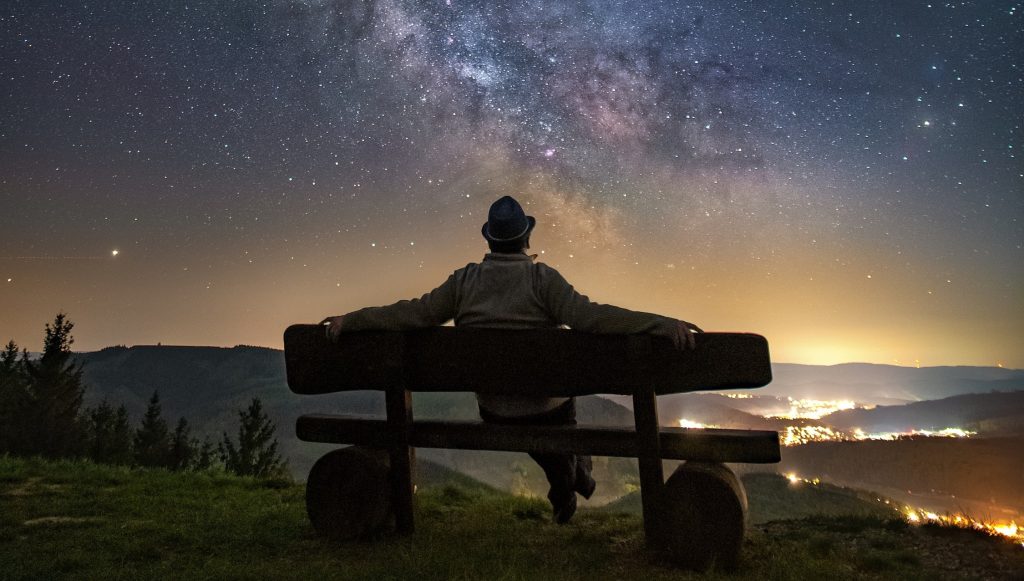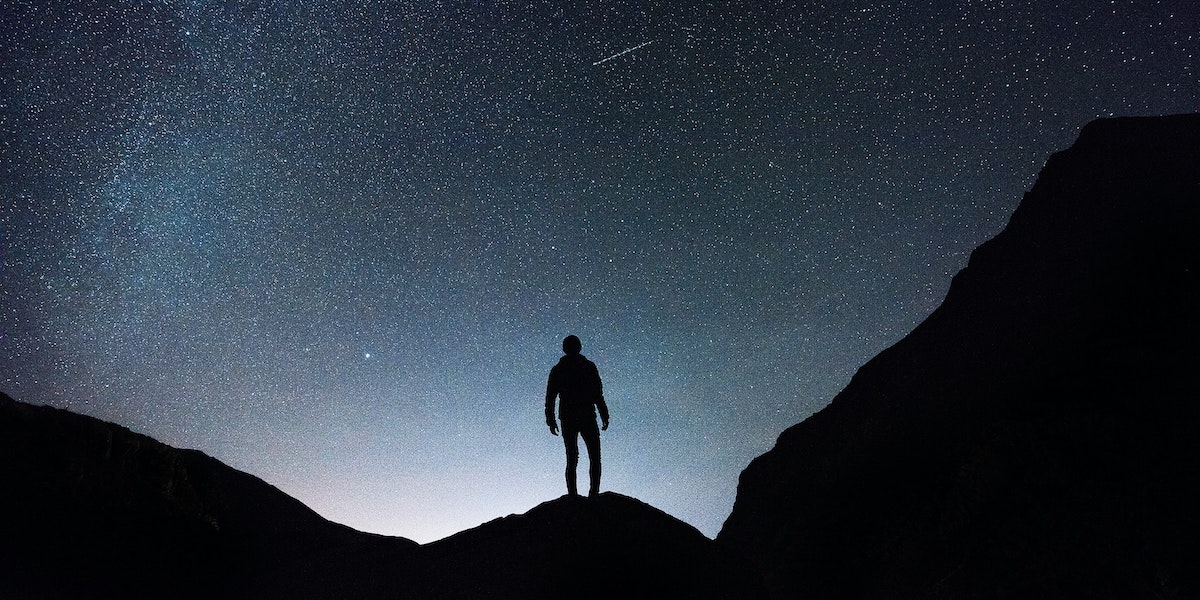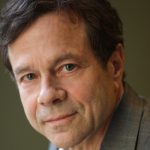Alan Lightman is a physicist, novelist, and essayist who was the first person to receive a dual faculty appointment in science and the humanities at MIT. He received his PhD in theoretical physics from the California Institute of Technology, and is the author of the internationally acclaimed Einstein’s Dreams, which has been translated into thirty languages around the world. He recently sat down with Next Big Idea Club Senior Editor Jeremy Price to talk about beauty, fulfillment, and the wonders of the universe.
This conversation has been edited and condensed. To watch the full version, click the video below.
Jeremy: In your new book, Probable Impossibilities, you talk about a remarkable moment you had as a boy, when you had this experience of “nothingness,” as you put it. Could you share that anecdote with us?
Alan: I grew up in a suburb of Memphis, Tennessee. One day when I was around nine years old, I had just heard a train go by, and suddenly I had this feeling of being transported into outer space, and being connected with the cosmos. I felt like the infinite time before I was born and the infinite time after I would be gone were compressed to a dot, and I felt incredibly insignificant—but also kind of grand. It was a cosmic moment of awareness of myself as a particle in the universe.
Jeremy: Incredible. Do you feel that experience influenced your chosen career path as a physicist?
Alan: It might have been a pivotal moment, or it might have been a reflection that I was already philosophically and scientifically inclined. Even from that young age, my mind naturally thought about these big questions. I spent a lot of time in my room alone, writing poetry about death and beauty. I was in my head a lot, and I still am—to the great dismay of my wife and children.
Jeremy: Understood, I definitely hear that.
Let’s pivot toward the ideas in your book. For example, you have this one essay called “In Defense of Disorder.” And this surprised me—I had assumed that a physicist like you would prefer order and predictability and logic. So tell us about why disorder should be defended.
Alan: Well for one example, we need certain random mutations to cause evolution to work. If we didn’t have random genetic mutations, there never would have been any evolution of animal life leading up to human life.
We also know that for every particle, there’s an antiparticle. And when the two meet, they merge and disappear and produce pure energy. But if the universe were created with an equal amount of matter and antimatter, all of that matter and antimatter would have annihilated itself. There would only be pure energy, and there would be no matter left to make stars and planets and alligators and people. So there was a little bit more matter than antimatter in the early universe, and that allowed everything to be made. We wouldn’t have anything but pure energy if not for that little bit of asymmetry, that little bit of disorder.
“I like to shake up my life every ten years or so. The combination of order and disorder is really important.”
Also, novelists have known for a long time that if you create a character who is completely orderly and completely predictable, that’s an uninteresting, boring character. The most interesting characters—the ones who represent real, complex people—have some unpredictability in them.
Jeremy: Yes, that’s so true. I’ve heard something similar about good endings to stories, that a good ending is both surprising and inevitable. A blend of order and disorder is what makes something interesting, and I think that’s actually why I love magic tricks so much. When I see a playing card appear or disappear into thin air, my scientific, orderly view of the cosmos gets thrown out the window for a moment—and there’s something kind of thrilling about that. I think something special would be lost if that disorder were absent.
I also love how you connect order and disorder to the notion of yin and yang, opposites coming together to form a whole. And that made me reflect on how the most fulfilling life, for me anyway, seems to be a dance between things changing and things staying the same. I think that too much of one or the other, too much order or too much disorder, wouldn’t be good; maybe you need both in order to be happy and fulfilled. What do you think?
Alan: I totally agree. I live in a house with two cars and a wife and children, and it’s a very orderly life—but several times a year, I like to travel, and go to far-off places that I haven’t been before. And in general, I like to shake up my life every ten years or so, and completely rethink what I’m doing and where I’m going. The combination of order and disorder is really important.
One of the most famous art critics of the 20th century, Ernst Gombrich, once said that we like symmetry, but we also need a certain amount of asymmetry for a painting to be beautiful. If it’s all symmetrical, it’s kind of boring—we need a little splash of red in the left-hand corner, or a face where one eye sags a little bit below the other. But if there’s too much asymmetry, then it’s not beautiful anymore. So you need a background of symmetry on which to impose a little bit of asymmetry here and there.
Jeremy: Definitely. And since your wife is a painter, I’m sure that example hits close to home.

There’s another idea from your book that I wanted to touch on. A lot of people seem to believe that for human life to matter in this vast, huge cosmos, there needs to be some kind of deity, some sort of god that cares about us. And what I love is that, whether or not there is a god, you explain why human life is pretty darn special on its own, even given the enormity of the cosmos—or perhaps especially given the enormity of the cosmos. Tell me more about that.
Alan: So, we think that life is rare in the universe in terms of the amount of matter that is in living form. You can look at the fraction of Earth that’s in living form, and if you assume that every star has one or two habitable planets, and some fraction of those have living matter, you can estimate what fraction of the atoms in the universe are in the special arrangement to constitute life. And it’s a very, very tiny fraction—one billionth of one billionth. It’s like one grain of sand in the Gobi Desert.
So life is very rare in terms of the material, but also in terms of the time during the evolution of the universe in which life can occur. We think that we need stars to make life, because all of the elements in any living thing that are heavier than hydrogen and helium were made in stars, and then then blown out into space.
In addition, galaxies throughout the universe are moving away from one another at increasing speed, and we can calculate a time in the future, maybe 100 billion years from now, when we will be totally out of contact with the rest of the universe. And when our sun burns up, there will no longer be any supply of energy, and life will disappear. So if you think that the universe will last an infinite length of time, which we do think now, then there’s only a narrow window, maybe a billion years to 100 billion years, where life can arise at all. In the grand sweep of the lifetime of the universe, there’s only one frame of the film in which living things exist. So life of any kind is rare, both in space and in time.
Jeremy: I feel like there are two different directions you could go with that thought. On the one hand, you can feel profoundly insignificant, but on the other hand, you can feel this invigorating amazement that we exist at all. So instead of feeling this terrified hopelessness at the precarity of life in the universe, how can we instead reach this place of awe and gratitude?
Alan: Well, most of us don’t think about life in the universe as a whole—we think about our individual lives. So it’s really related to the question of how we face our own individual mortality. The human lifespan is around 100 years, so how do we deal with that 100 years? Mary Oliver wrote a wonderful poem, and the last line was something like, what are you going to do with your one, crazy moment?
“We intelligent beings are the only groups of atoms that can observe the spectacle of the universe.”
The way that I deal with my mortality is to imagine that I am part of a long chain of humanity that stretches into the distant past and into the distant future. And even though my individual life—the special arrangement of atoms that is “Alan Lightman”—will dissociate, and my atoms will be scattered into the wind, water, and air, I will have been part of that long chain of humanity. Some of those atoms will then become parts of other people—in fact, each one of us now has, in our body, atoms of people who lived before us. We don’t know who those people were, but in a way, it means that they continue on, and so will you. It offers a glimpse of immortality.
Jeremy: That’s beautifully said. And it makes me think of the astonishing fact that with every breath you take, you’re likely inhaling atoms that were breathed by every person who has ever lived on Earth. When I think about people that I’ve loved and lost, that brings me a certain degree of comfort—that with every breath I take, a part of them is still with me.
In the book, you also talk a lot about what you call “cosmic biocentrism.” Could you clarify what that is, and what it means for our secret connection to other life forms?
Alan: That phrase started with a term that other people developed called “biocentrism,” which is the idea that all biological things on Earth are connected. The “cosmic” part comes in because astronomers have no doubt that there are other intelligent beings elsewhere in the universe; the odds are just too great, whether we can communicate with them or not.
All intelligent living things have this special arrangement of atoms that constitute life and consciousness, and that gives us all a kind of kinship. But there’s something else that connects us: We intelligent beings are the only groups of atoms that can observe the spectacle of the universe. I mean, you can imagine nature existing but with no life in it—just mountains and oceans, but no life. And it might be beautiful, but there would be no one there to record the beauty, or to say, “This is beautiful.” The cosmos is this incredible panorama of planets and stars and trees and oceans and colors and rainbows and rings orbiting planets and black holes colliding and just an unfathomable number of phenomena. But it’s only the intelligent beings that can witness it. We are the observers, and that connects us to other intelligent beings out there. We are all witnesses to this spectacle.

Jeremy: I love that. And I think it’s a process of both witnessing that beauty and also creating it. Color, for example, doesn’t exist inherently “out there” in nature. It’s something the brain creates when it interprets different frequencies of light. So when you think about something like a rainbow, without anyone to see it and create those colors in their brain, that rainbow literally would not exist. So by witnessing the grandeur of the universe, not only are we getting to experience this completely remarkable thing that we call existence, but we’re also bringing to the table certain phenomena that literally would not exist without us being present. Would you say that’s a fair comment?
Alan: I think that’s 90 percent fair. Those different frequencies of light would be there with or without us—but when it comes to the sensation of color, I totally agree that that requires a photoreceptor, namely an eye, and then a nervous system and a brain to register all of that.
And of course, we create things beyond just sensing things. We build buildings, we play music, we create paintings. Whether or not the beauty of those created things can compete with the beauty of nature is another matter—but we are creators and participants as well as observers, as you said.
Jeremy: That’s a great way of putting it.
So let’s say that you had the chance to send one message to a conscious, intelligent alien being. What would your one message be?
Alan: Hmm… I might say, “Can you send me a picture of yourself?” I would most like to know what they looked like, because that would tell us a lot about the uniqueness of the evolution of life on Earth. So you know, maybe they’re not embodied at all. Maybe they’re just patterns of electromagnetic waves or something like that.
Jeremy: That’s so interesting. Is there any physical or psychological quality that you think is fundamental, that would be shared by all sentient life?
Alan: I think that all life forms, whether they’re intelligent or not, evolve. I’ve been talking to a biologist at Harvard named Jack Szostak who is trying to create life from scratch, and I asked him, “What is it that constitutes life? Where do you draw the line between something that’s alive and something that’s not alive?” He said, “I don’t think of it in those terms. I think of it in terms of, ‘What can I create that’s going to evolve?’” Because once you have a compartment that encloses a region and separates it from the outside world, and you have some chemicals in there that can utilize energy, and you have some chemicals in there that can reproduce and carry instructions like an RNA molecule, then it should automatically change and evolve. I think that’s fundamental to life.
Jeremy: That’s really interesting—so maybe it’s less a matter of form and more a matter of function. It’s not what life is, but what life does that counts.
“Each one of us now has, in our body, atoms of people who lived before us. In a way, it means that they continue on—and so will you.”
One thing that struck me as a common thread running through a lot of your essays is the notion of returning to where we began. There’s this discussion of scientists trying to recreate the very beginnings of life in a lab, for example, and you also write about returning to your childhood home as an adult. So I’m getting the sense that perhaps progress itself is a march toward our origins, sort of like the infinity symbol on the cover of your book—if you trace it with your finger, you eventually end up back where you started. Do you think there’s a certain cyclical nature to human life?
Alan: I think the fundamental question is, “What are we?” We think that we’re nothing more than a special arrangement of atoms and molecules, but how did that arrangement develop? Since the 1950s, we’ve known the structure of DNA, but how did DNA get to be DNA? If we keep asking questions like that, we eventually get back to not just the origins of us, but of all living things on Earth. And then, where did the Earth come from? Where did the Sun come from? If we keep bootstrapping ourselves backwards in time, we come to the Big Bang about 14 billion years ago. Where did that come from? So if we start with the question of “What are we?” and follow it in all directions, we’re pushing to the infinities on both sides of us—the infinity of the small and the infinity of the large.
Jeremy: I think what you illuminated just then was an interesting dynamic that we often see in stories and myths. You see a protagonist go on some sort of outward, physical journey, but ultimately it’s also a journey into themselves, a journey of self-discovery. And what I didn’t fully appreciate until now is that maybe the same is true of science. Maybe as science continues to progress, to go on this journey, maybe that is also an inward journey. It’s a matter of discovering who we are as a species, and figuring out what those insights mean to us as individuals.
Alan: I agree. You said it better than I did.
Jeremy: Well coming from you, that’s quite an honor.
You’ve done such incredible thinking and writing about both the universe and the human condition. So I was wondering if you could leave us with one piece of wisdom about human life that you would like to impart upon the world.
Alan: Do unto others as you would have them do unto you. Every religion on Earth subscribes to that rule of moral and ethical behavior, so I think it’s an absolute. I think if you live by that one rule, you will be a good person.
Pick up a copy of Alan’s new book, Probable Impossibilities: Musings on Beginnings and Endings, from Amazon, Bookshop.org, or your local bookstore. And for more big ideas from leading thinkers, download the Next Big Idea App today:






























